Category Archive for Art + Design
Aomori, Japan: A ghostly Gothic travel guide! Haunted Mount Osore, Misawa art museums, Terayama Shuji memorial.

Feeling so nostalgic for Japan… I miss the era when we could party all night, and share absinthe freely! At this rate, I’m not sure when I can safely return.
Thankfully, I have a crew of Pirates — and we can live vicariously through their travel adventures in Japan and beyond.

Today, we’re letting our favorite spooky lady, Yukiro Dravarious, steer the ship… with a guide to traveling in Aomori, Japan! Read on for bizarre and Buddhist art, and a visit to Mount Osore, a hell-like volcano haunted by Gothic spirits.
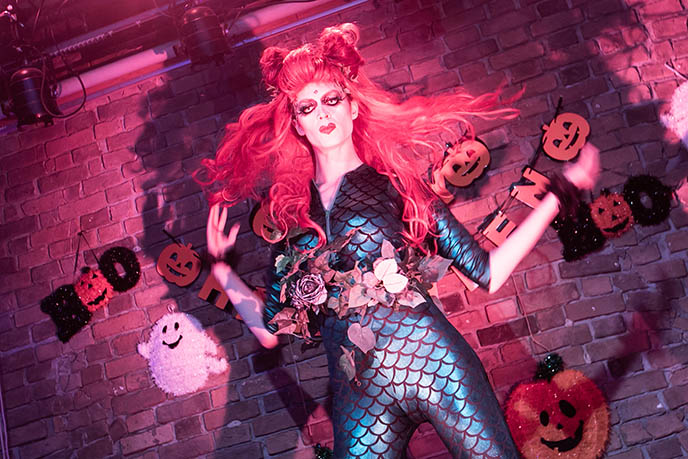
Before I turn over the wheel, I wanted to share some of Yukiro’s recent drag photos and projects (as Die Schwarze Frau). She and her Haus of Schwarz did a live, socially-distanced performance for Tokyo Closet Ball. Watch it here; our dead diva comes alive near the end.
For more fabulosity, check out Yukiro’s Witch Review series on YouTube — it breaks down the best horror B-movies, without spoilers!

And you’re invited to Yukiro’s online Halloween party on October 10, 8pm Japan time! Tune into the event here — Casket of Horrors. All members of her drag Haus will perform live, followed by a battle to the death between 10 spooky video contestants.
If this Evil Queen’s genius makes you bow down in awe, show your support by buying Yukiro a glass of red wine here.
(Above photos by: Akane Kiyohara from Beauty Blenda, by Haus of Gaishoku.)
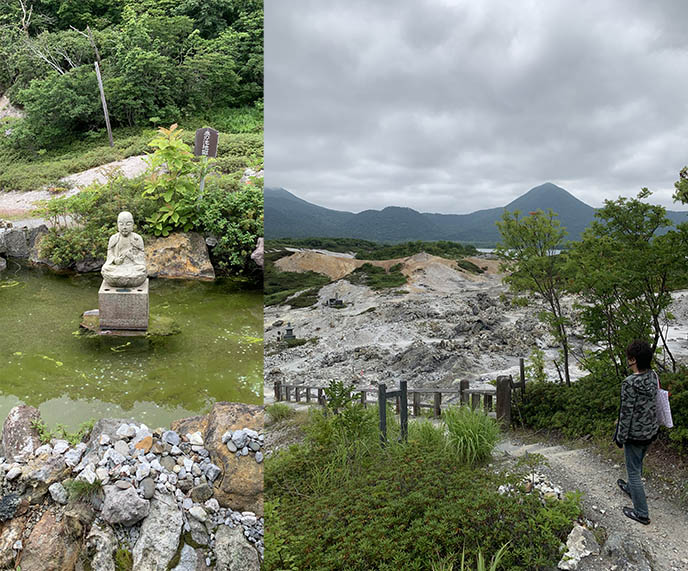
Now gather round children, and let’s listen to Yukiro’s Aomori travel story…
In July, my boyfriend and I escaped the Tokyo heatwave by taking a local trip to Aomori. It was our first time visiting the northernmost region of Japanʼs main island Honshu (本州), right below Hokkaido. We researched where to go and what to see – as well as the government’s safety recommendations, as our priority was to minimize the risk of getting or spreading COVID-19.
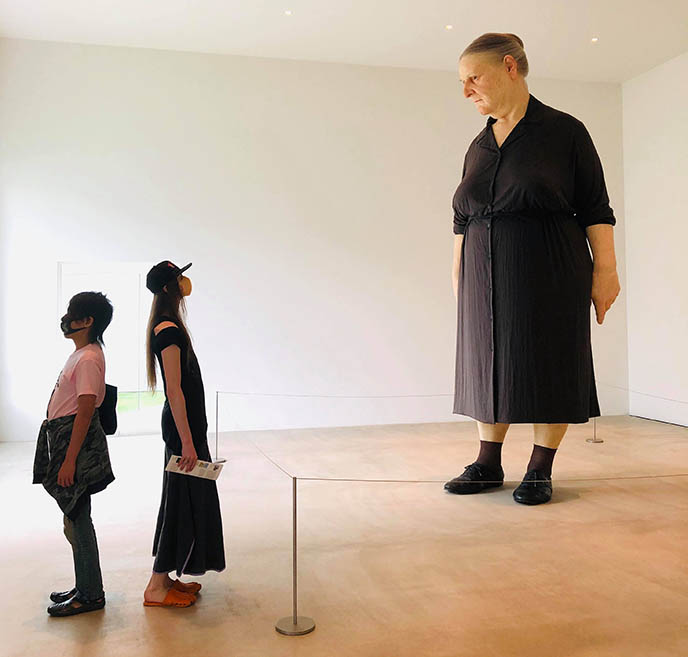
Our shinkansen route: We took the bullet train to Hachinohe (八戸) from Tokyo Station. Then, we took a local train to Misawa (三沢) where we booked our hotel. The trip took about 4 hours and cost about 18000 yen one way. We travelled just before the Japanese summer vacation so we avoided crowds, and got a very reasonable deal on our hotel, Hoshino Resort Aomoriya (less than 5000 yen per person a night!)

Pro tip: Pack a mask and hand sanitizer, and avoid crowded trains and rush hours. Our trains were more or less empty, and we saw almost no humans during this trip. Just what we desired!
Misawa is a rejuvenating spot, and we were delighted by the brisk air, surrounding nature, and no humans as far as the eye could see. Between Misawa station and the hotel, there was a 10-15 min walking path through small waterfalls and meadows.

Our hotel, Hoshino Aomoriya, was one of the best I’ve been to in Japan. We had an airy room and relaxation area. It bordered a Japanese park filled with art, birds, pony rides, jogging routes, and a pond with lotus flowers and auspicious carp fish.
The hotel also had two natural onsen (hot springs) free of charge for hotel guests, with both inside and outside options. The outdoor onsen was especially spirited as it was surrounded by trees, a pond, and trailing pink flowers.

The hotel displayed art from Okamoto Taro (岡本太郎); I loved his kappa-like spirit depiction. I was impressed by the collection of nebuta, or gigantic paper figures in the form of dragons, gods or Shoguns. Some were 9 meters in length, and spat out smoke and lights. Aomori has a yearly Nebuta festival (ねぶた祭) every summer, but it was cancelled due to the virus. In the future, I hope I can see this procession of musicians, dancers, and locals carrying the giant white floats.
I carried my mosquito repellent and sun lotion and hand sanitizer in my bag, as well as sunglasses and a mask of course. I was expecting mosquitoes but to my delight I wasnʼt bitten once in Aomori! In Tokyo I get bitten 1-3 times a day if I donʼt wear full cover up or spray myself heavily with repellent.

We chose to stay in Misawa because it was close to the memorial museum of Terayama Shuji (寺山修司). He’s an avant-garde poet, dramatist, writer, and film director — one of the most influential Japanese artists. Iʼm a big fan of his provocative movies and was eager to learn more about this extraordinary man.
Getting to the Terayama Shuuji museum: We took a 20 minute taxi ride from Misawa station, since there are only connecting buses on weekends and during vacations. All museums (and most stores) are also closed on Mondays in the Misawa area, and you more or less need a car to efficiently get around Aomori.
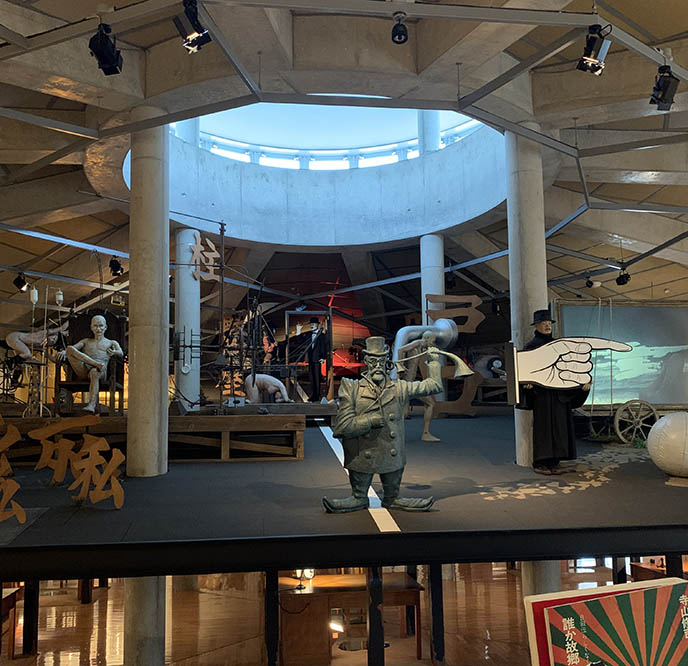
Needless to say the Terayama Shuji museum was very much worth the costly taxi ride (4000 yen one way). Every guest has to get their temperatures checked, and wear plastic gloves provided by the museum, as well as pay a small admission fee of 400 yen.

Terayama Shuji’s museum was as kooky and wicked as one would expect. The first room was a traditional exhibition space about his career, along with books, merchandise and collaboration pieces.
The second was very impressive since it was designed like a treasure hunt! There were 12 desks, and you had to use a flashlight, open drawers and find secret hidden panels. Each bench contained keywords to help solve the riddles. Inside the desk drawers were more facts, poems and interesting curiosa regarding Terayama; some even projected movie clips. The other parts of the room contained a library, and a ceiling constellation of his bizarre characters being lit up one after another. We bought some goods and left, without seeing another single visitor, and were very pleased.
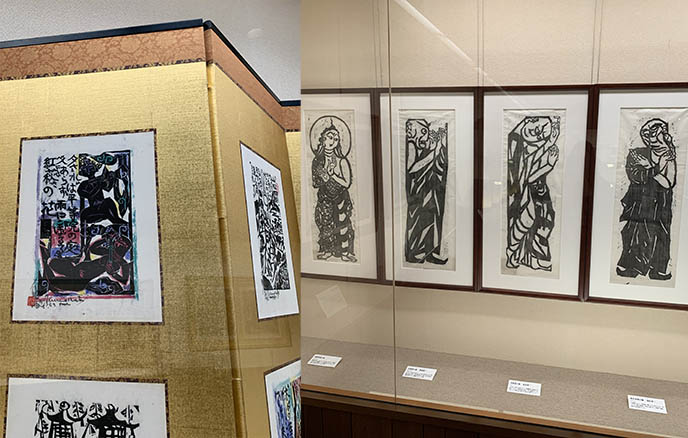
We then took the local train to Aomori city, and from the station, we rode a bus to Heiwa Park (the Park of Peace – 平和公園) , which is said to be haunted! Unfortunately we did not encounter any ghastly beings, as it was empty as everywhere.
Then, we paid 400 yen to visit the memorial museum of Shikō Munakata (棟方 志功), a woodblock printmaker who reached international fame. Munakata was known for his eccentric personality and obsession with Vincent van Gogh; at a young age he claimed to be the “Van Gogh of Aomori.” The grandest piece in the museum was his “Ten Great Disciples of the Buddha” (二菩薩釈迦十大弟子) (1939), considered to be his crowning achievement.
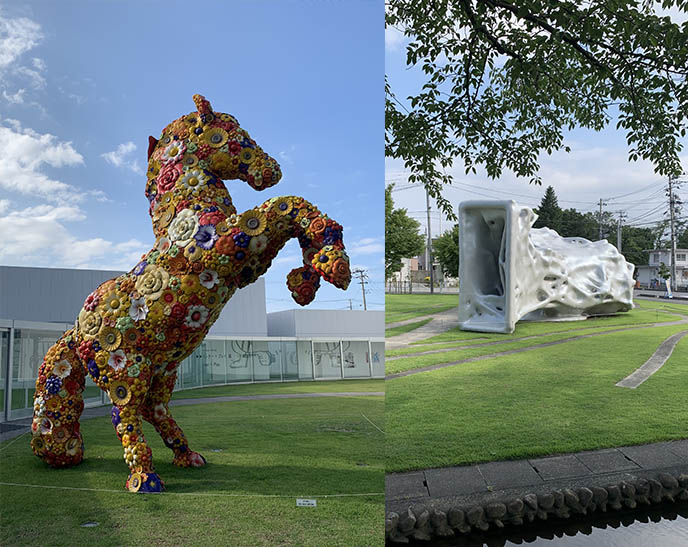
The following day we had the pleasure of meeting a local friend, Yoko, who kindly took time to rent a car and take us to must-see places. We realized how difficult it is to travel around Aomori without a car, so her help really made our trip worth writing about!
Our first stop was the Towada Art Center (十和田現代美術館). Outside, there was free street art for anyone to enjoy.

The infamous Yayoi Kusama (草間彌生) had an art platform opposite the main building, featuring her recognizable dotted sculptures. We also saw firefighters climbing a wall that was surprisingly part of the exhibit, and a friendly ghost manifestation.
PS: see La Carmina’s review of the Stockholm Yayoi Kusama exhibit here, as well as her trip to Naoshima Island (land of the giant pumpkins).
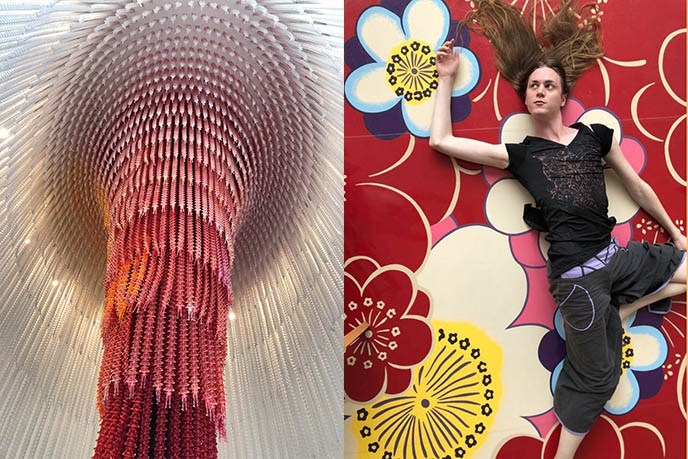
Also exciting was the Wish Tree, planted by Yoko Ono; you wrote your wish on a paper strip and hung it on one of the branches.
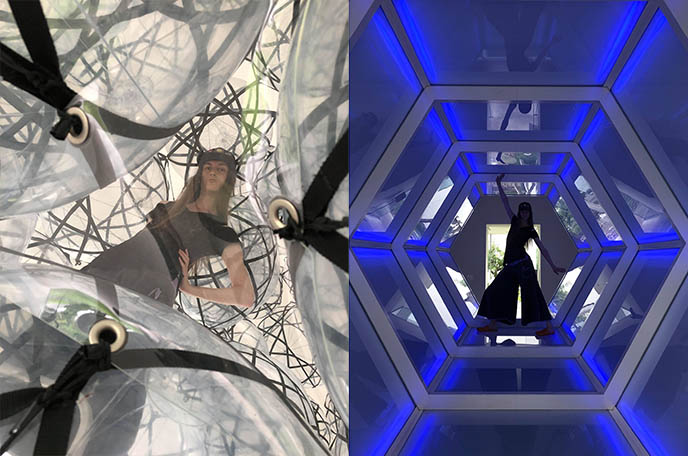
I enjoyed Towada’s many interactive pieces, and slightly hidden art that you had to search for. We took fantastic photos amidst the glass walls, and enjoyed installations from artists around the globe.

Next, Yoko took us to the Oirase Gorge (奥入瀬渓流) – a long path for hikers, through jaw-dropping waterfalls and picturesque trees. The gorge stretches 14 km from Nenokuchi (子ノ口) on Lake Towada (十和田湖) to Yakiyama (焼山). The strong current leads through a ferocious path with many rocks.
When we went, there was mud because of rain, and the thicket of trees made the temperatures quite cool. Even in the peak of the summer, I recommend wearing rubber boots and an extra coat layer.

After a few scenic stops, we made it to the peaceful Lake Towada, the largest caldera lake on Honshu Island. On one of the rocks in the water we could spot a tiny shrine, which belongs to a god who protects the lake. Yoko took us to Towada Shrine (十和田神社), and we admired the mossy stones that are said to have healing powers.

We also saw the “Statue of Virgins” (おとめ像) on the beach side of the lake. It’s the last remaining work of poet and sculptor Takamura Kōtarō (高村光太郎), and in our eyes, looked more like a romance between two women. Thanks to Yoko, we had a lovely day of nature and art.
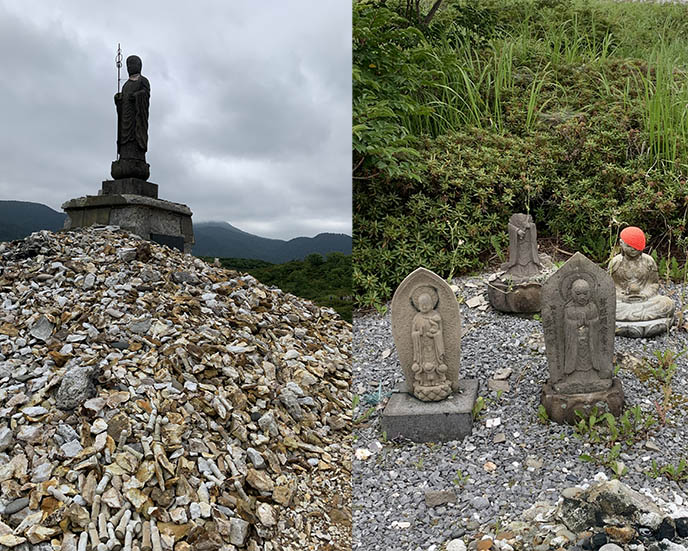
The next day we went to Mt. Osore, the Mountain of Dread: one of the three most sacred places in Japan. It is also a main shooting location for Terayama Shuuji’s movie “Pastoral: to die in the country” (田園に死 す).
Mount Osore is home to psychic mediums called “itako” who are traditionally blind, and undergo rigorous spiritual training. Itakos can summon the soul of a dead person; they become possessed, and speak to the customer in their spirit’s voice!
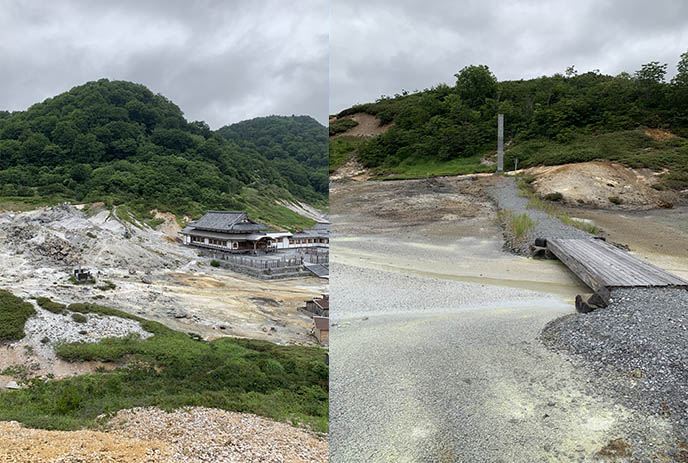
How to get to Mt Osore: From Misawa, take the express train direct to Shimokita Staton (下北), or take the local and transfer at Noheji station. (Not to be confused with Shimokitazawa, the hipster area in Tokyo frequently shortened to Shimokita!) Then, ride one of the three daily 40 minute buses to Osore. The trip took about 2-3 hours and cost 1900 yen for the train and 800 yen for the bus ride, per person each way.

Arriving at Mount Osore was like entering another realm. The holy ground is said to have spirits of the dead roaming about. It is also an active volcano, and is believed in Japanese mythology to be one of the gates to the underworld.

Admission info: The entry fee for adults is 500 yen, and there’s an overnight option with meals included for 12000 yen. The festivals with Itako spirit readings take place between July 20-24, and the area is open 6:00-18:00 each day between 1st of May to 31st of Oct (imagine going there on Halloween.) Osore is too cold in the winter for humans to visit… but not for spirits!
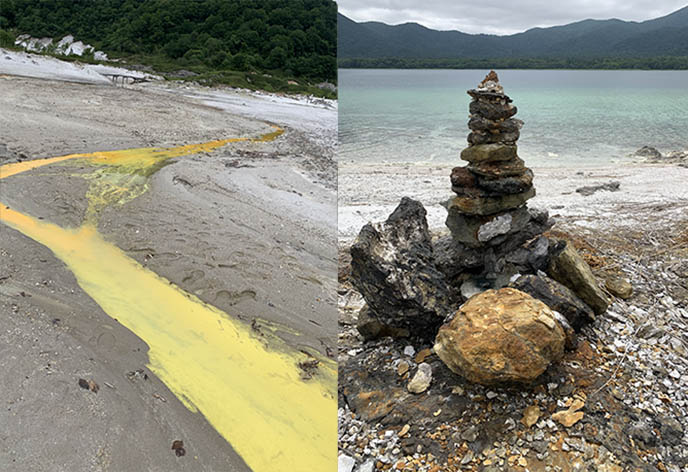
The place is gigantic, so allow several hours to walk around. The main temple, Bodaiji (菩提寺), is said to be founded 1200 years ago by the monk Enʼnin (円仁), and belongs to the Sōtō division of Zen Buddhism. The sanctimonious Mount Osore contains the highly acidic waters of the caldera lake. Lake Usori is in the center, surrounded by 8 mountain peaks representing the lotus flower’s 8 petals.
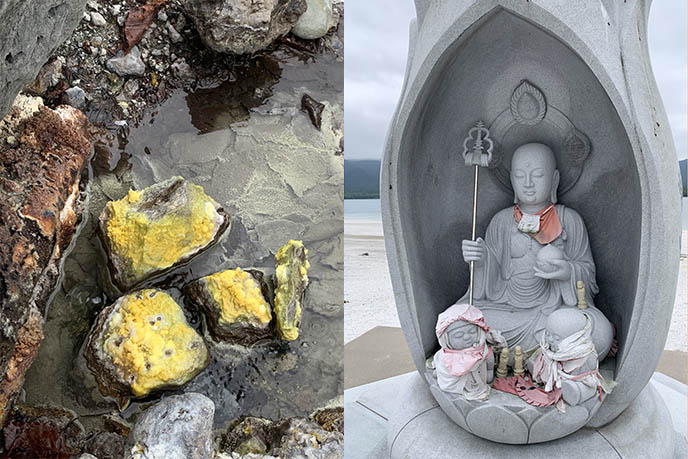
The area has many fumaroles (openings of the planet’s crust) emitting steam and volcanic gases (especially sulfur dioxide… the smell was everywhere). There are exactly 108 fumaroles, representing the 108 worldly desires and the 108 hells bound to them. Some of these hells even had their own signs with dramatic names, such as: The hell of salt, The eternal hell, The hell of severe crimes, and the hell of the blood-pounding pond!
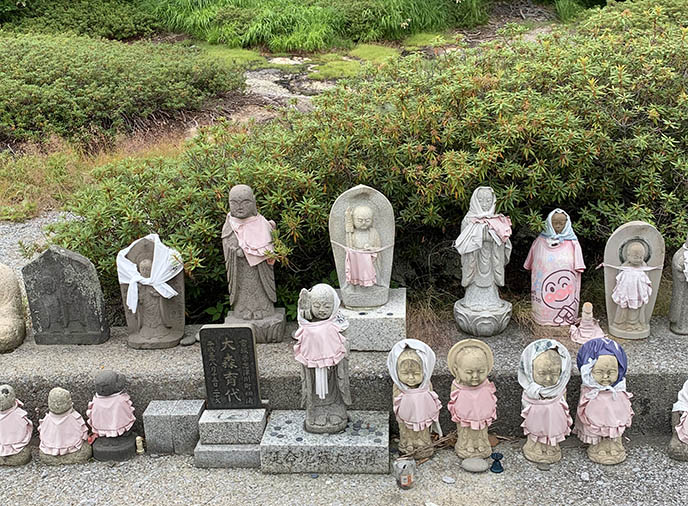
Mount Osore looked like a demon landscape. The paths bubbled with sulphuric yellow, orange or blue, while the white sand and grey stones made the scenery look like an endless graveyard. Adding to the melancholy were hundreds of Jizou bodhisattva (地蔵菩薩), or stone figures that guard over children who have died. Many of these small stone monks were clothed in handmade baby bibs and hats.

We saw pyres and monuments to famous monks, as well as offerings of cute pink windmill toys (風車). This famous Japanese toy represents unborn children, and is said to help them find peace in the afterlife. Seeing so many was heartbreaking and overwhelming.
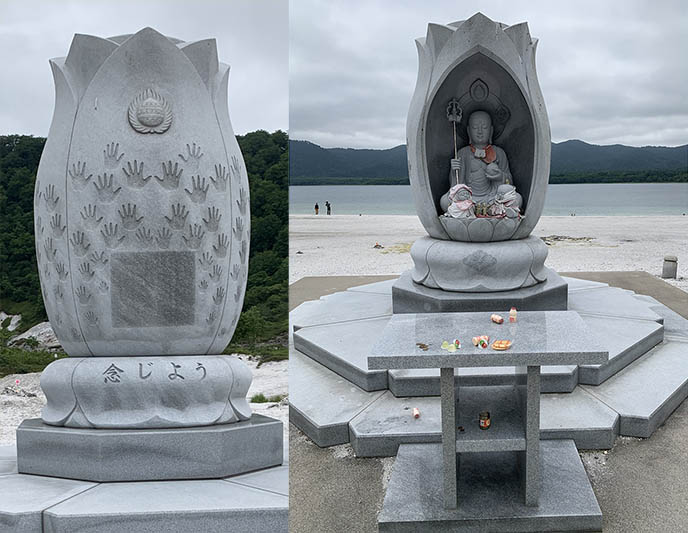
Osore had other meaningful tributes to those who have passed. I saw a large urn, shaped like a giant lotus, with hand-prints (mainly of children) on the back side. This was a monument for the unfortunate souls who died in Japan’s 2011 tsunami and earthquake.
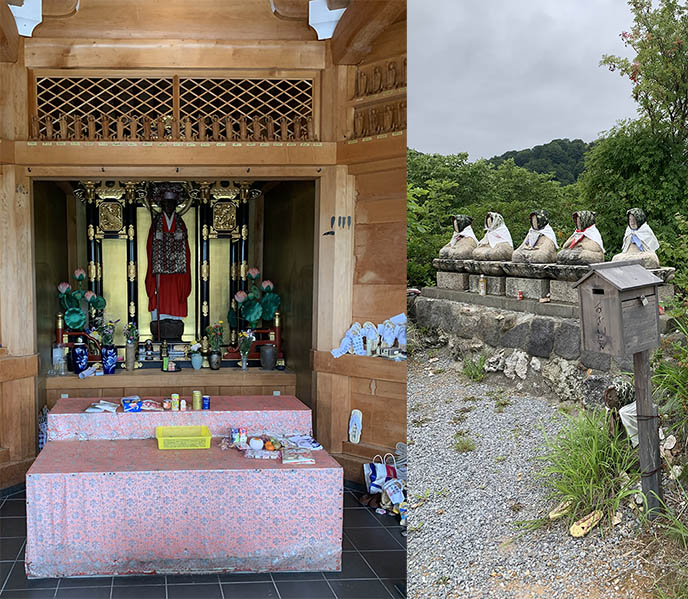
In one hut, I found heirlooms and old clothes belonging to the dead, with names of the unborn written on wood stripes all over the ceiling.
In Japanese media, the Mountain of Dread tends to be portrayed as a haunted place. It is said that you are cursed if you take any stones from the holy ground. In fact, this is a site of meaningful stillness and remembrance, which really spoke to me. While I loved the otherworldly Gothic atmosphere, I also felt this was one of the most serene places I’ve ever visited. There was no malice in the air – just a solemn peacefulness.

On the last day of our journey, we took a local train from Hachinohe to Shark Town station (伸), where there were an obnoxiously high number of seagulls by a shrine. These were actually “Black-tailed gulls” (Umineko 海猫). Fun fact: the word in Japanese Umi-neko is a compound of Umi – ocean and Neko – cat, so basically they are called “sea cats” or “cats of the ocean.”

We walked 10 minutes from Shark Station to Kabushima Shrine (蕪島神社) and as we got closer, we started hearing cat-like cries. It turned into a screeching as we approached the small harbour. Unlike regular seagulls, these beasts had black tails, a red ring around their eyes, a black mark on the beaks, and a sharp red tip: as if they’d just dug into raw flesh and still had blood dripping from their Gothic faces.
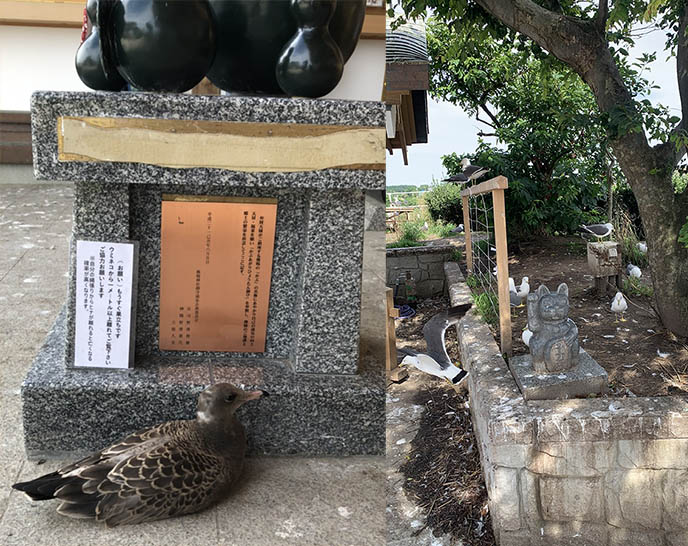
The little shrine on the hill burnt down in 2015 but was rebuilt as of last year. The workers stopped construction while the gulls were hatching their babies, so they could raise them in peace. In mid July, the hatchlings still wore a brown coat of feathers but were as large as adults. I was stunned by how they were unafraid of humans; you basically had to be careful not to step on them.

As you can imagine there was bird poop absolutely everywhere and we were afraid of being targeted from above! I would recommend this shrine if you are a fan of animals and birds in particular, but only if you have some extra time in Aomori. On the contrary, if you have a phobia or were freaked out by Alfred Hitchcockʼs “The Birds” I would suggest never to step your foot at Kabushima shrine!

Thanks to Yukiro for the eye-opening guide to Aomori! I didn’t realize there was so much avantgarde art and spiritual / Gothic scenery in this region of Japan. (Here are a few final pics from Towada Art Center.) Hopefully I can visit soon.

For more from Yukiro, watch his latest (freak)show drag performance here. The entire Haus of Schwarz (Stefani ST Sl;t , Le Horla, and Angel Heart) performed, with mommy dearest Die Schwarze Frau near the end! Le Horla’s spooky makeup was put on by Haus’ Drag Dad, Weryk.
If want something unproductive to do during quarantine, watch Yukiro’s YouTube series, Witch Review. Die Schwarze Frau dishes on her favorite old school horror cult B movies, sharing her darkest thoughts with you! There are no spoilers, so you can watch these reviews in (ill)-faith.
And if you’re inspired to dress in Gothic or Punk clothing, check out Punk Rave Store — they have many dark styles for men and women.

And we order you to tune in to Yukiro’s Halloween livestream extravaganza, called Casket of Horrors! All members of Haus der Schwärze will perform live, and then there will be 10 spooky videos submitted from around the globe. The winner will be crowned “The Queen (or Queer) of Halloween 2020!” Watch the live-stream online (here’s the info) on 2020/10/10 at 20:00 Japan time, if you dare.
Love it to death? Then support Yukiro by buying him a glass of red wine here!

SHARE & COMMENT
Stahl House LA tour: Iconic mid-century modern home! Los Angeles architecture, Beetle House Tim Burton restaurant.
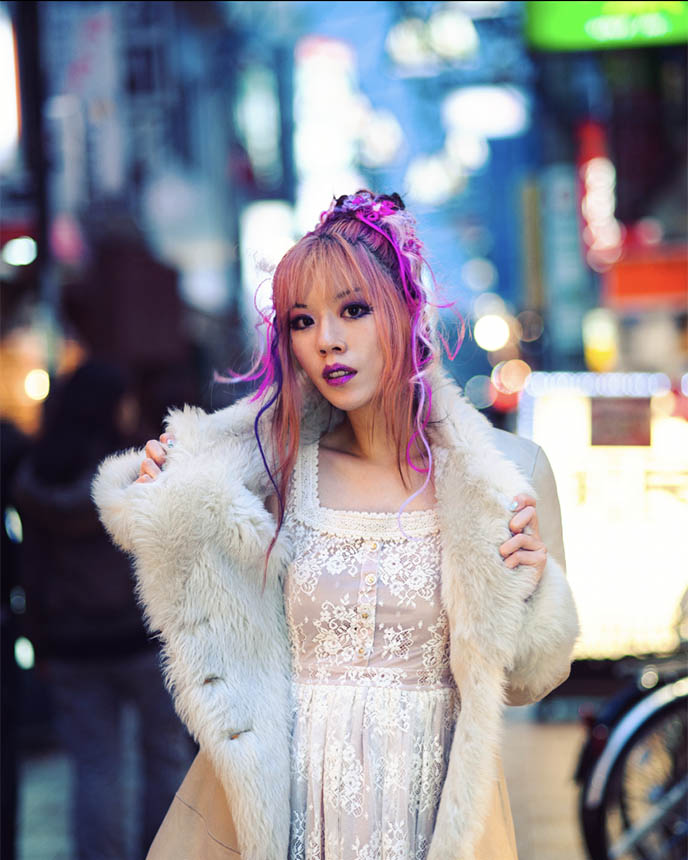
Pinch me… I’m traveling somewhere fun in a few days!
This will be my first trip since Portland in late February… and 100% in accordance with the B.C. government’s travel and social distancing guidelines. (I’m forever on the cautious side, when it comes to Covid… and I wish more people were.)
Can you guess where I’m going? Take a peek at my social media —@lacarmina Instagram, Twitter, Facebook — to be part of my journey.
(This Tokyo photo by Said Karlsson is unrelated, but expresses my excitement… and how much I miss Japan. Never thought the country would be cut off from me like this. Can’t wait to go back).
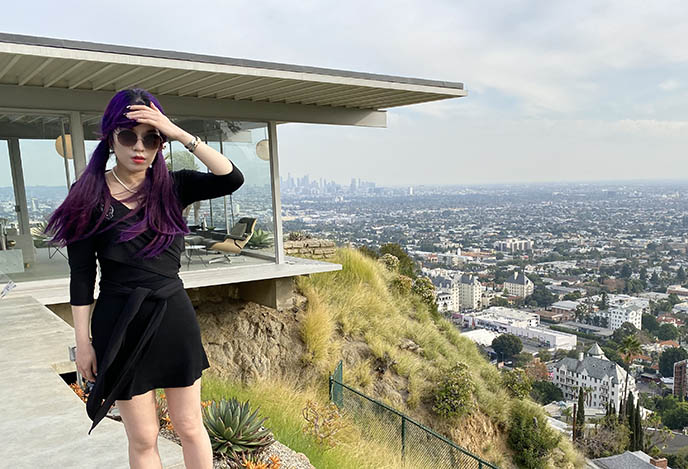
But this eagle’s nest wouldn’t be a bad spot to spend quarantine, am I right? Seated in an Eames Lounge Chair, overlooking the Hollywood Hills…
Architecture fans, this one’s for you. When I was in Los Angeles last January, I got to tour Stahl House — glass masterpiece of mid-century modern architecture.
To top off this fabulous day, I had dinner at Beetle House: a Gothic Halloween theme restaurant that honors the world of Tim Burton. Read til the end, to see me hanging with Jack Skellington and Edwards Scissorhands!

I couldn’t visit Stahl House without re-creating the famous black and white photo, taken by Julius Shulman in 1960 (there’s a shot of it further down). Architect Pierre Koenig’s glass house has fascinated me for years, and I jumped at the chance to finally see it in person.
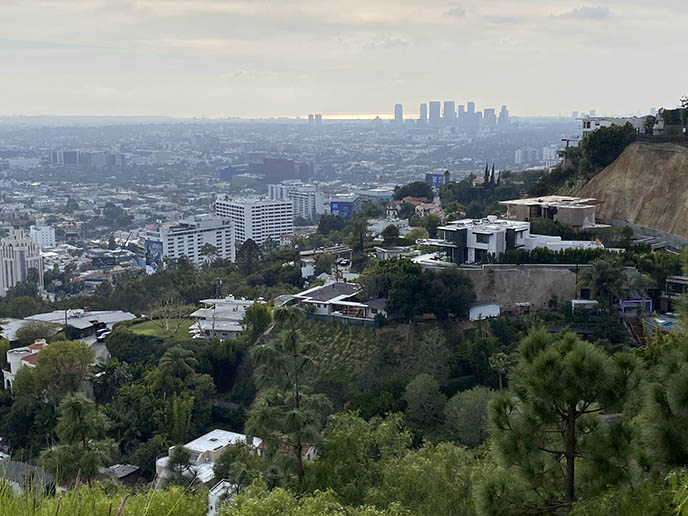
Don’t just drive to Stahl House (1635 Woods Drive), as this is a private property and you won’t be able to see anything from outside. To properly visit, you must book a guided tour well in advance, through Stahl House’s website. (Of course, this isn’t possible with Covid right now — but bookmark this for the future.)
Stahl House only offers a limited number of small-group tours, and they sell out extremely quickly (often months in advance). I messaged them to find out when the next month’s slots would be released, and got tickets on that exact day.

The narrow, winding streets have limited parking space, so you’re encouraged to carpool or ride-share, and arrive early.
I parked in the carport, and waited with anticipation in front of the C.S.H. #22 glass door. (This refers to Case Study House No. 22, one of the experimental residential homes commissioned by Arts & Architecture Magazine from 1945-1966.)
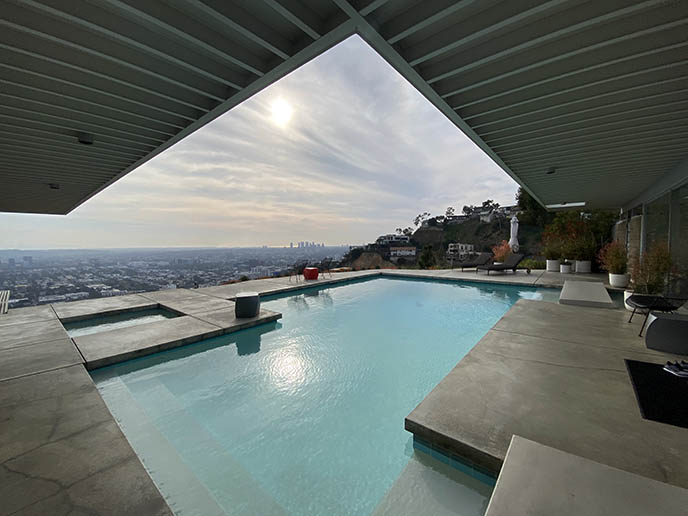
As soon as the guide lets you in, you’ll understand why Stahl House is an icon of American mid-century design.
Built in 1960, this dreamy residence wasn’t a party pad for a celebrity. It was the beloved home of an ordinary family with three kids! Imagine spending your childhood waking up to these views, and plunging into the pool.
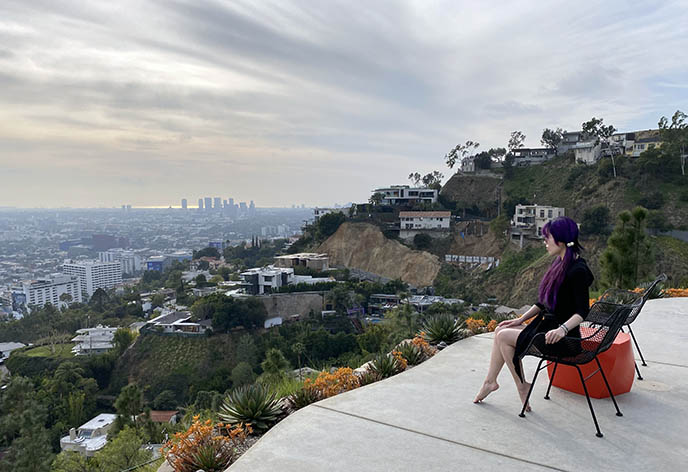
In 1954, Bruce Stahl (Buck) and his wife Carlotta bought the undeveloped land for $13,500. They brought their vision to young architect Pierre Koenig, and he made this modernist fairytale home come to life.
Much of the construction was DIY — Buck gathered discarded concrete from around the city, and pieced it together to make the foundation. (It would be impossible to build Stahl House today, as it would violate current zoning and safety laws!)
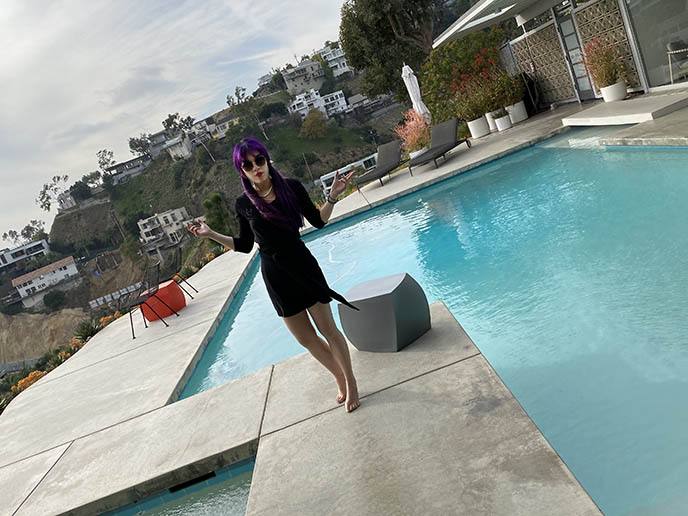
The afternoon tour lasts an hour. Our guide first let us wander and take photos. Then, we gathered in the living room to hear how Stahl House came to be.
Did I adopt a barefoot lifestyle in LA? Not quite. All guests must take off their shoes to avoid damaging the property. In addition, you can only take photos with a smartphone, so leave your DSLR and video cameras at home. (Good thing I had upgraded to an iPhone 11.)
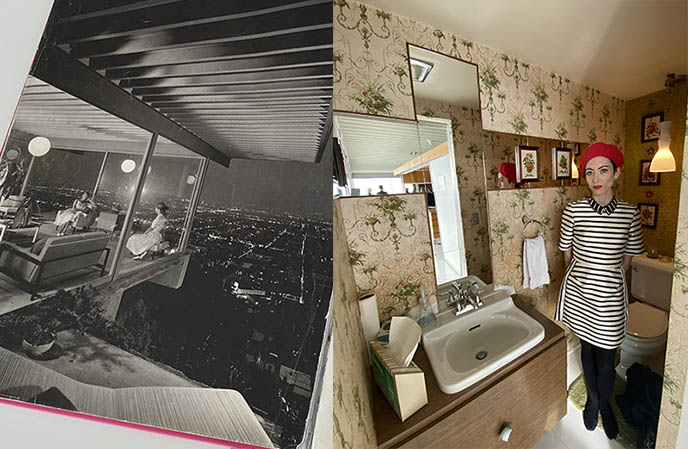
Photographer Julius Shulman visited Stahl House in 1960, and snapped this well-known image of two women chatting in the corner at night.
Lauren and I had fun sitting in the exact spot as these ladies. But we also got a kick out of seeing the parts of Stahl House that are never photographed… like the tiny wallpapered bathroom!
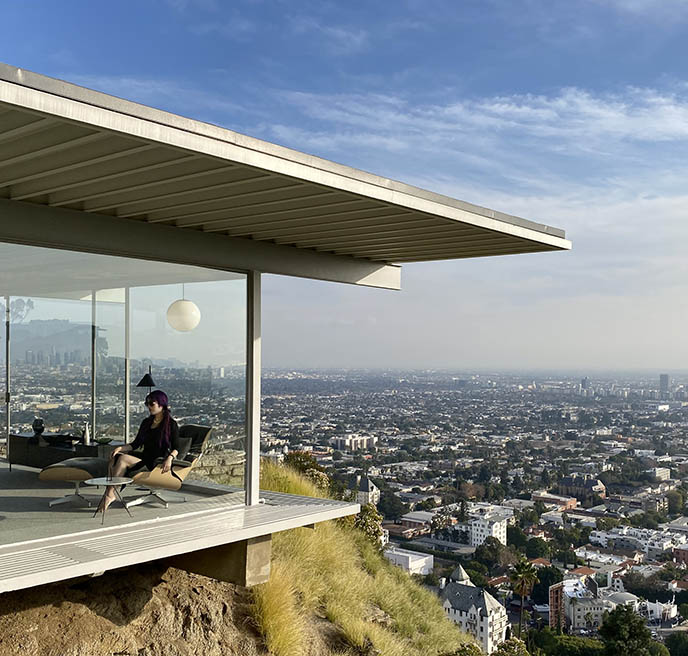
Here’s my tribute to Shulman’s Stahl House photo. The angle captures the magic of lounging in the living room, which seems to float over Laurel Canyon. Clean lines and panoramic views… modernist perfection.
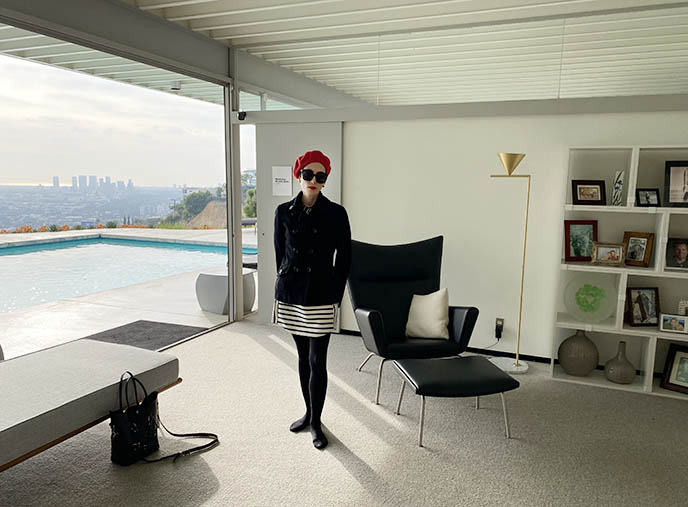
We got to explore most of the 2200 square foot house at our leisure. (One of the two bedrooms was off-limits, as well as one of the bathrooms. But we got full access to the kitchen, dining and living rooms).
Stahl House was furnished in collaboration with Design Within Reach, purveyors of modern furniture. If you’ve seen photos of my apartment, then you’ll know I adore these types of interiors.
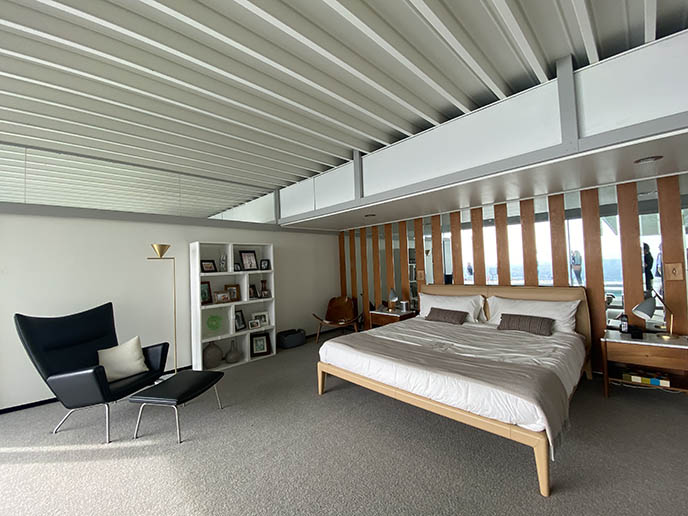
Every room has floor-to-ceiling glass windows, for mesmerizing views over Laurel Canyon LA.
We learned there were downsides to living in a”glass house” — the constant UV coming through the windows quickly faded the furniture and finishings. Stahl House had to be constantly maintained by the family to keep it true to its original incarnation. (The property is owned and managed by the three children who grew up here.)
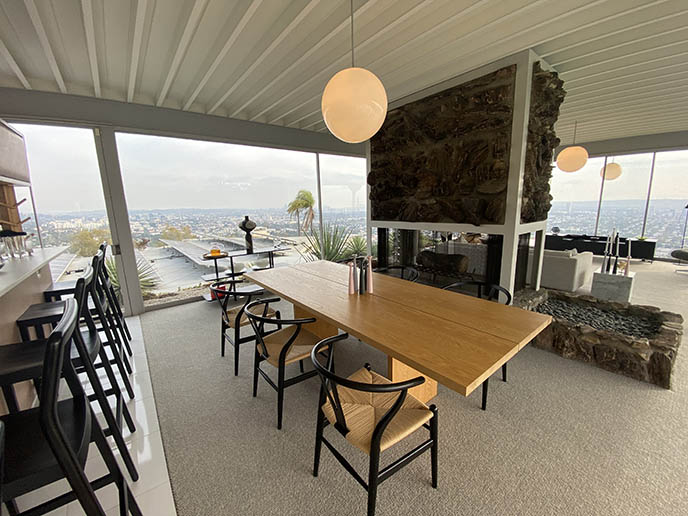
Stahl House was an “open concept” pioneer. The stone fireplace divides the living room from the cooking and dining areas.
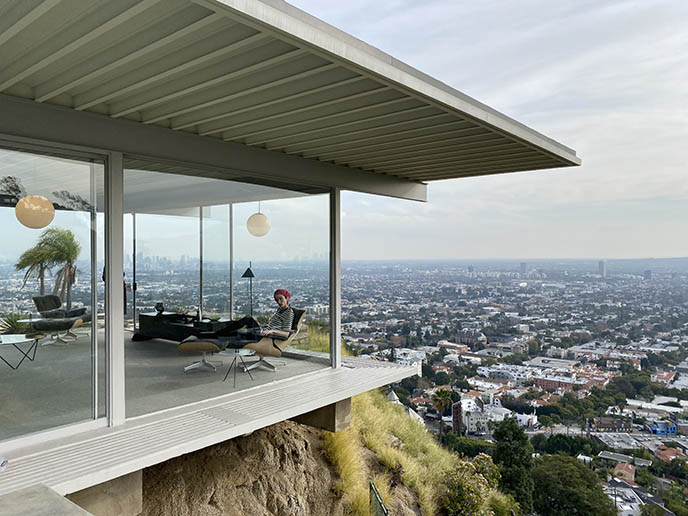
This Eames lounge chair and ottoman fits in perfectly with the glass, steel and concrete.
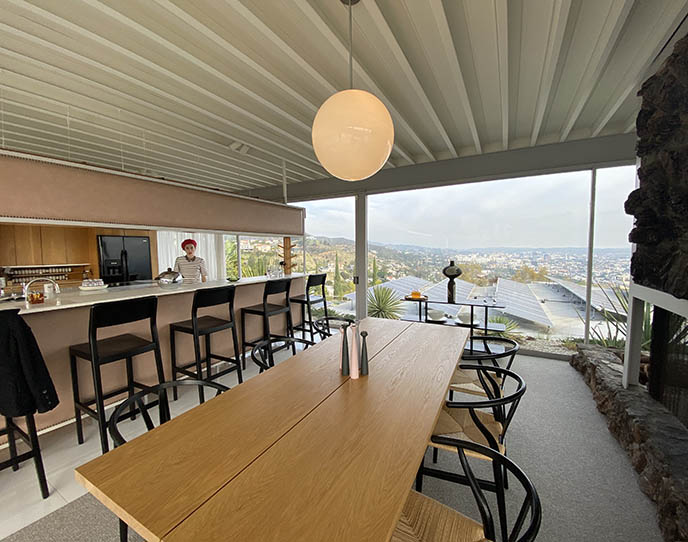
The minimalist furniture from Design Within Reach complements the white-oak kitchen cabinets. Stahl House is photogenic from every perspective; no wonder it has been featured in many movies and fashion shoots.
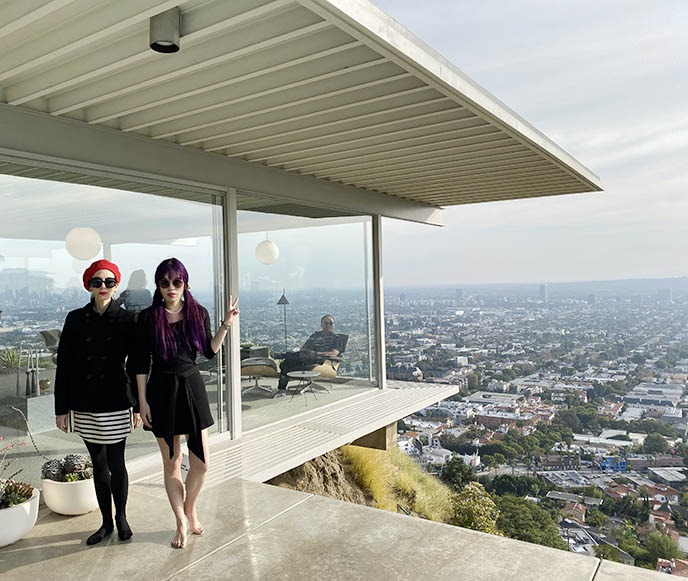
Watch your step, and don’t get distracted by the views… There’s a steep drop off the balcony landing, and no safety net.
Talk about “living on the edge!”
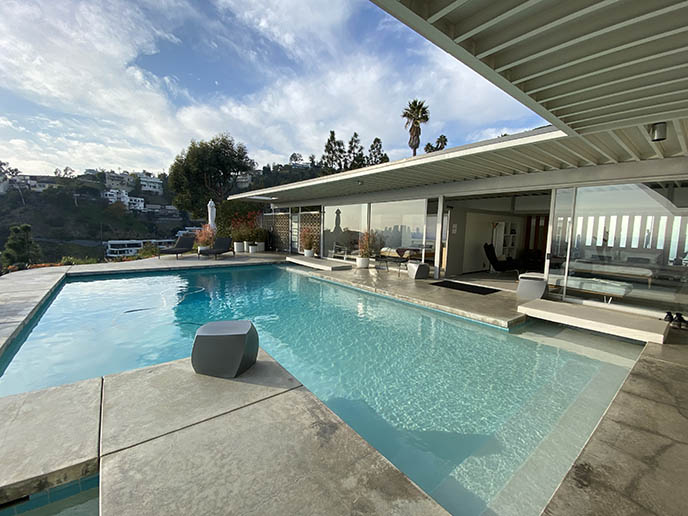
We learned that the Stahl children would roller-skate around the concrete decking, and jump from the rooftop into the pool… Ah, the carefree 1960s and 1970s.
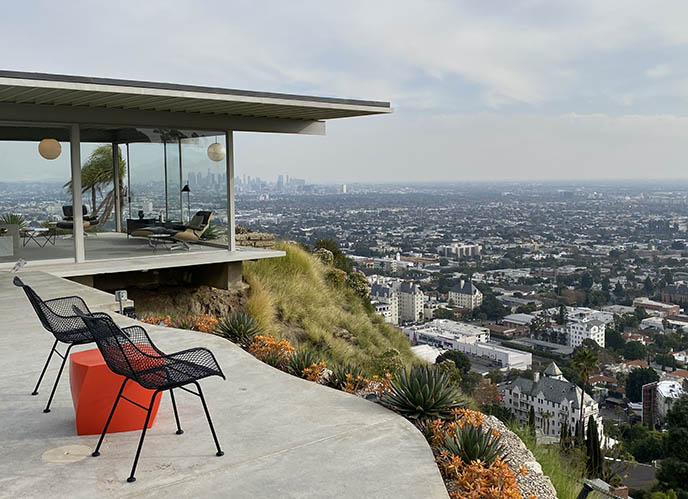
When Stahl House’s reservations open up again, be sure to book tickets as far in advance as possible. There are limited time slots and each tour has maximum 20 people.
Our guide wasn’t sure how long the family would be running these tours for the public, or if the home may be sold in the future. If you get the chance to see Stahl House, jump at it!
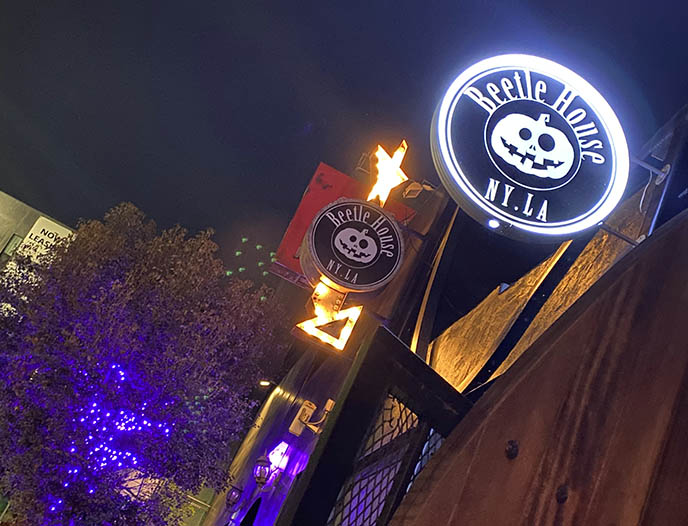
This inspiring day wasn’t over yet. We headed to Hollywood for dinner and drinks at Beetle House LA.
This theme restaurant tips its hat to the Beetlejuice movie, Halloween and Tim Burton’s cinematic oeuvre (but it’s not owned or officially associated with the Gothic director). Beetle House has locations in both Los Angeles and New York, as you can gleam from the grinning pumpkin logo.
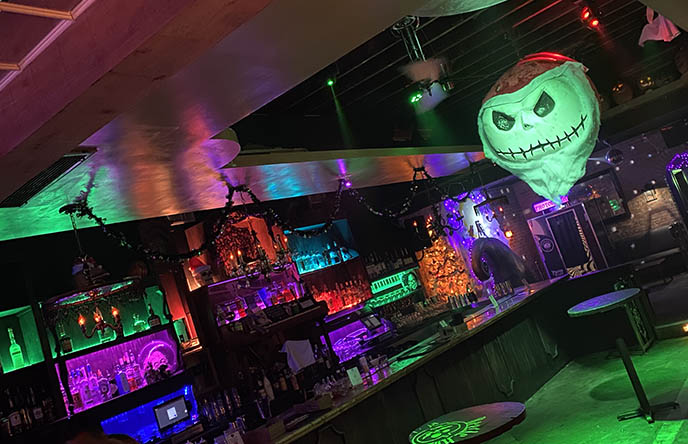
For fans of Tim Burton movies, Beetle House is a dream (or should I say nightmare!). A giant Jack Skellington in a Santa hat welcomes you to the neon-lit bar.
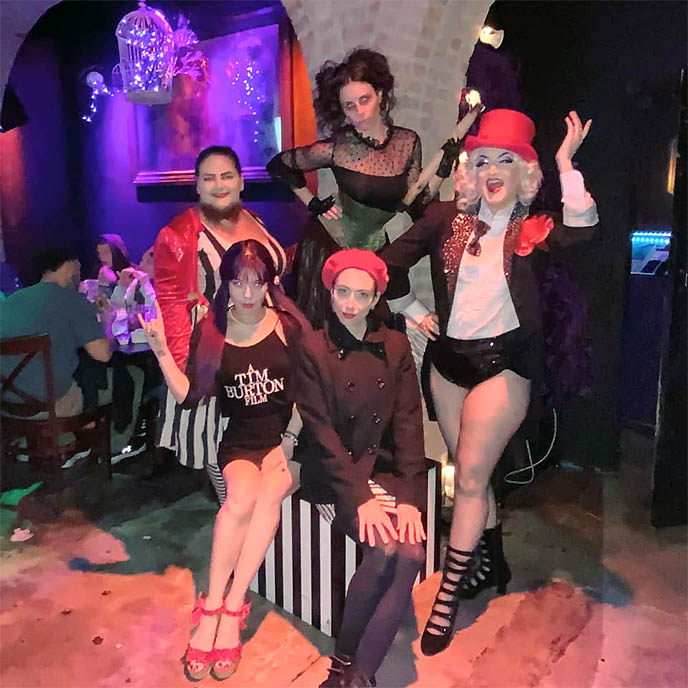
At Beetle House LA, every day is Halloween. Prepare yourself for an immersive dinner theater, featuring live performances by this spooky crew.
(Could there be a better haunt to wear my “A Tim Burton Film dress” from Forest Ink?”)
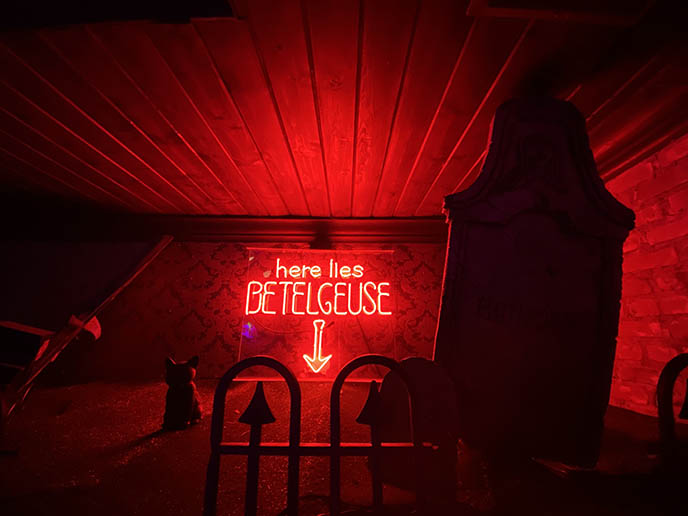
Every corner of the themed restaurant is filled with cheeky references to Tim Burton movies.
Here lies Betelgeuse. Dare to mutter his name three times in front of the tombstone, and see what happens!
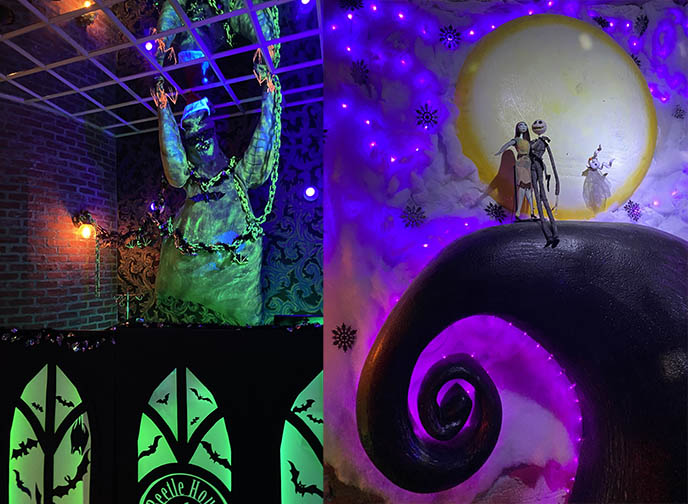
And here rises Oogie Boogie, and Sally and Jack from The Nightmare Before Christmas. (The purple lights and Gothic windows with bats add to the Burton feeling.)
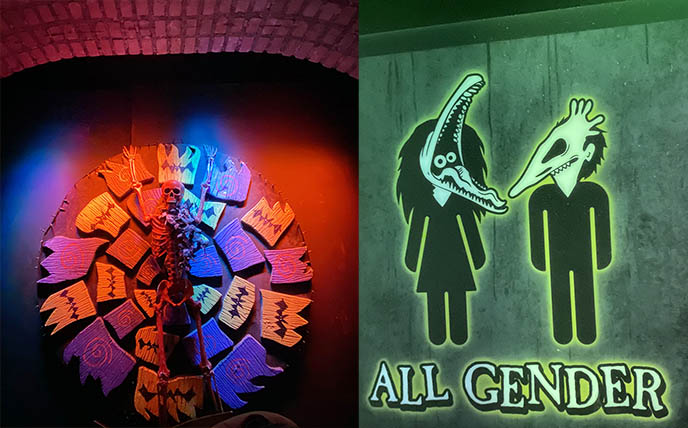
I spot skeletons on the wall, and an All Gender bathroom. Beetle House proclaims, “We are a safe place where every goth, punk, freak, weirdo, artist, and visitor is welcomed and celebrated.”
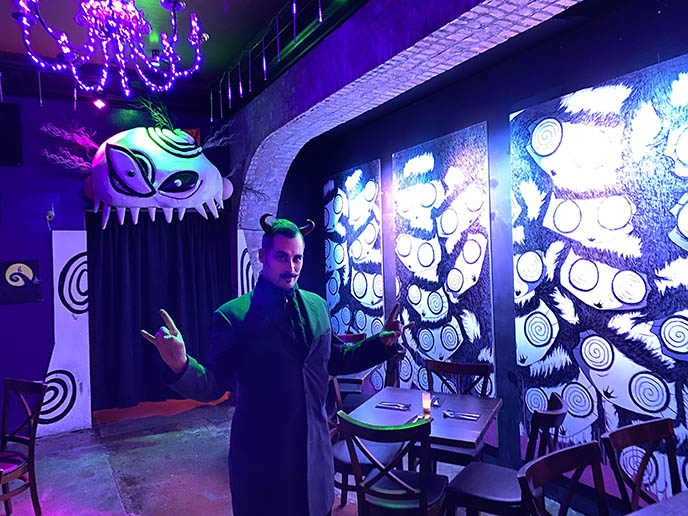
Quite fittingly, your host for the evening… is the devil himself.
Beetle House accepts dinner walk-ins, but tables tend to fill up especially on weekends — so I recommend that you make an advance reservation.
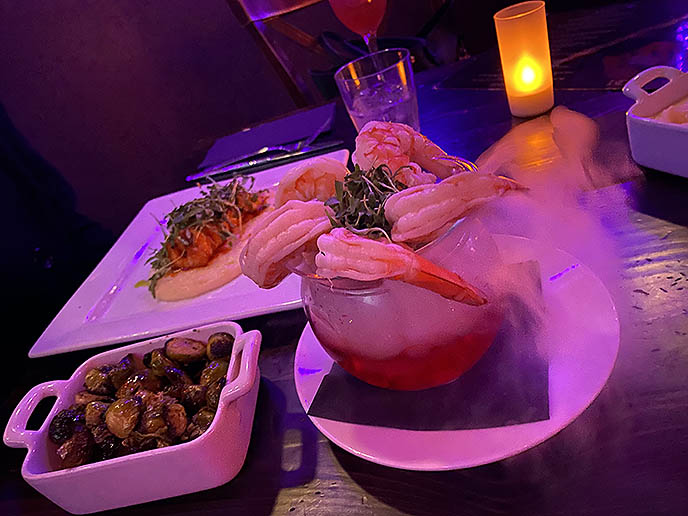
The $50 experience includes a tasty three course meal, and a theater show with rotating acts (who perform while you dine).
The menu includes cocktails with names like This Is Halloween (with pumpkin liquor), The Beetle’s Juice, and Alice’s Cup O’ Tea.
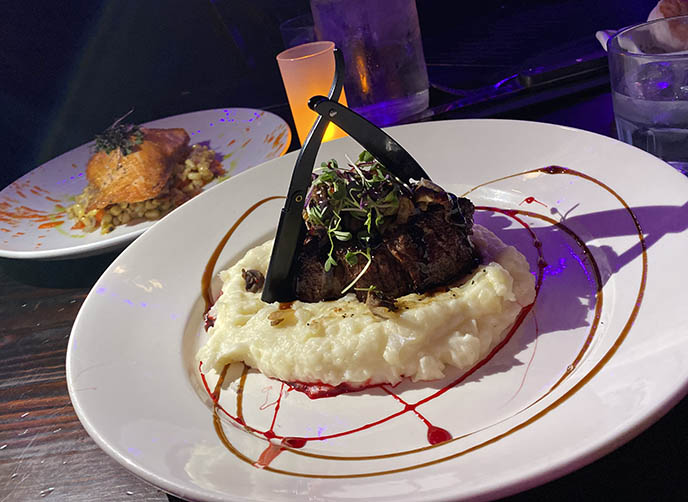
At Beetle House, the food is excellent, and presented with dramatic flair. We dined on Sweeney Beef (steak on a cloud of potatoes, with a drizzle of “blood” and topped with a razor!) The seared salmon with red pepper puree and sweet corn succotash is named Big Fish.
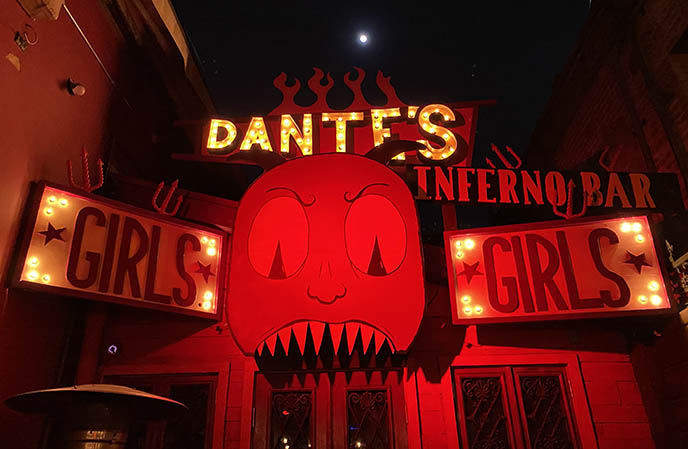
Head to the outdoor patio, and get swallowed by Dante’s Inferno Room. (It looks exactly like the Satanic hangout in Beetlejuice, where red-faced devil ladies entice the main character, played by Michael Keaton!)
The bar serves standalone drinks, with a focus on craft cocktails. You can also dare to drink the Hellfire Bowl, or take the 3 From Hell fiery shot challenge.
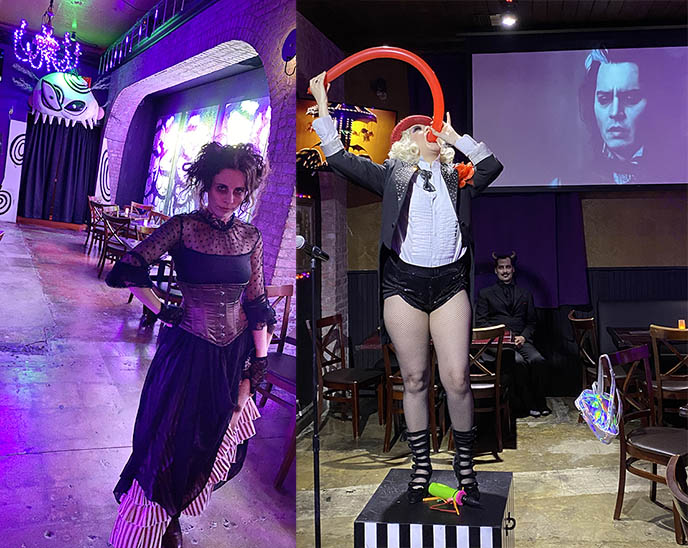
While we drank and ate, we watched immersive sideshow acts throughout the entire restaurant space. The performances are constantly changing; you may encounter magic tricks, contortionists, impersonators…
That night, we heard a song from Mrs. Lovett (played by Helena Bonham Carter in Sweeney Todd: The Demon Barber of Fleet Street.) Edward Scissorhands appears to be looking on in horror, at the balloon swallower!
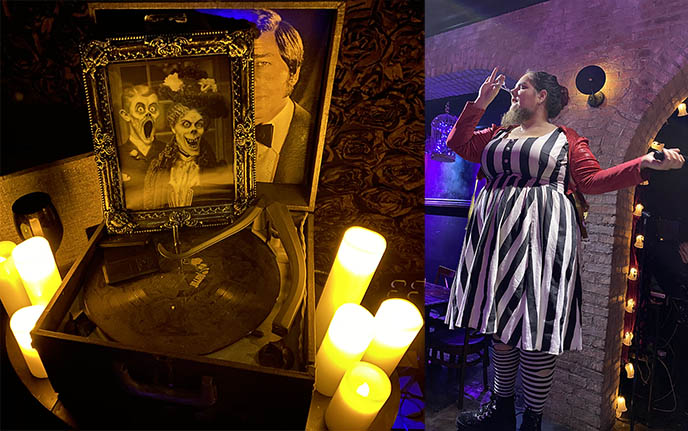
‘Twas an evening of frightful delights. (This bearded lady hammered nails into her nose, and then stuck scissors inside!)
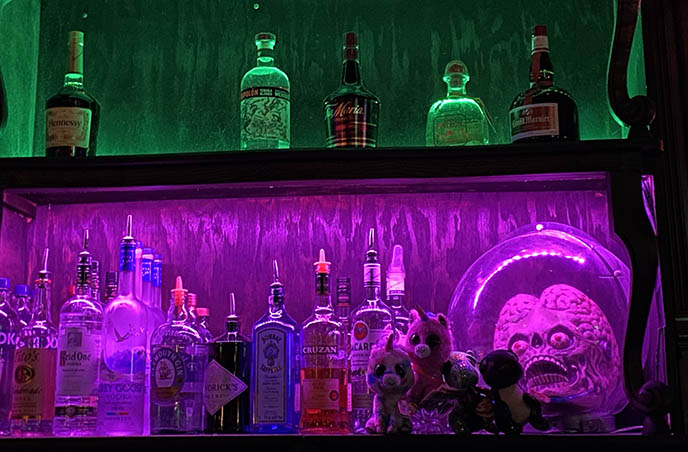
It’s been a weird year… I’d welcome the brainy aliens from Mars Attacks will return to Earth, and take matters into their own hands.
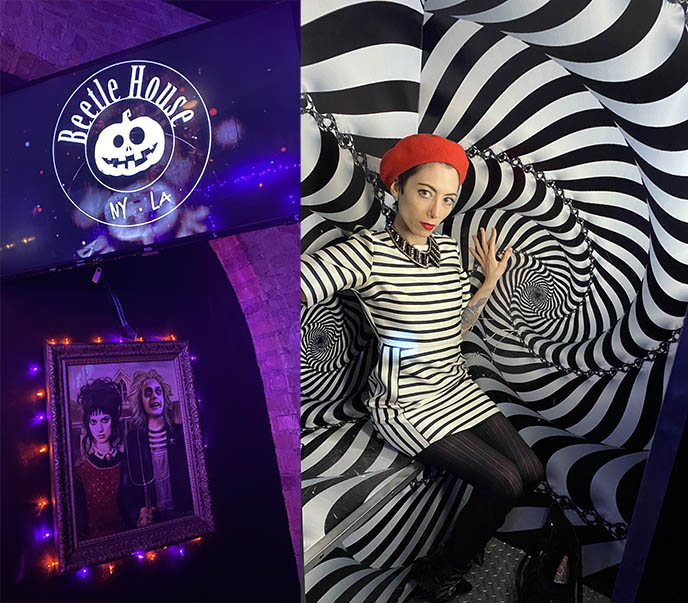
A last look at Tim Burton’s swirling visual aesthetic. Thanks Beetle House LA for an evening to remember.
Where would you prefer to spend your lockdown — at the modernist Stahl House, or a Halloween themed eatery?
Happy that I get to spread my wings a little, and do some travel this week… Add me on @lacarmina Instagram, Twitter, Facebook to see where I end up!
 LA CARMINA
LA CARMINA






